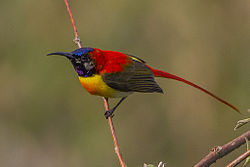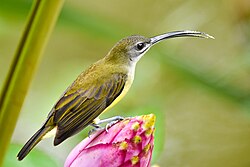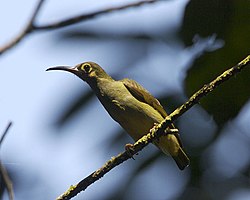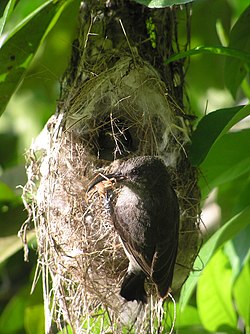| Image | Genus | Species |
|---|
 | Chalcoparia Cabanis, 1851 | |
 | Deleornis Wolters, 1977 | |
 | Anthreptes Swainson, 1832 | - Plain-backed sunbird, Anthreptes reichenowi
- Anchieta's sunbird, Anthreptes anchietae
- Plain sunbird, Anthreptes simplex
- Brown-throated sunbird, Anthreptes malacensis
- Grey-throated sunbird, Anthreptes griseigularis
- Red-throated sunbird, Anthreptes rhodolaemus
- Mangrove sunbird, Anthreptes gabonicus
- Western violet-backed sunbird, Anthreptes longuemarei
- Eastern violet-backed sunbird, Anthreptes orientalis
- Uluguru violet-backed sunbird, Anthreptes neglectus
- Violet-tailed sunbird, Anthreptes aurantius
- Little green sunbird, Anthreptes seimundi
- Yellow-chinned sunbird, Anthreptes rectirostris
- Grey-chinned sunbird, Anthreptes tephrolaemus
- Banded green sunbird, Anthreptes rubritorques
|
 | Hedydipna Cabanis, 1851 | |
 | Anabathmis Reichenow, 1905 | |
 | Dreptes Illiger, 1811 | |
 | Anthobaphes Cabanis, 1851 | |
 | Cyanomitra Reichenbach, 1853 | |
 | Chalcomitra Reichenbach, 1853 | |
 | Leptocoma Cabanis, 1851 | |
 | Nectarinia Illiger, 1811 | |
 | Drepanorhynchus Fischer & Reichenow, 1884 | |
 | Cinnyris Cuvier, 1816 | - Olive-bellied sunbird, Cinnyris chloropygius
- Tiny sunbird, Cinnyris minullus
- Eastern miombo sunbird, Cinnyris manoensis
- Western miombo sunbird, Cinnyris gertrudis
- Southern double-collared sunbird, Cinnyris chalybeus
- Neergaard's sunbird, Cinnyris neergaardi
- Rwenzori double-collared sunbird, Cinnyris stuhlmanni
- Whyte's double-collared sunbird, Cinnyris whytei
- Prigogine's double-collared sunbird, Cinnyris prigoginei
- Ludwig's double-collared sunbird, Cinnyris ludovicensis
- Northern double-collared sunbird, Cinnyris reichenowi
- Greater double-collared sunbird, Cinnyris afer
- Regal sunbird, Cinnyris regius
- Rockefeller's sunbird, Cinnyris rockefelleri
- Eastern double-collared sunbird, Cinnyris mediocris
- Usambara double-collared sunbird, Cinnyris usambaricus
- Forest double-collared sunbird, Cinnyris fuelleborni
- Moreau's sunbird, Cinnyris moreaui
- Beautiful sunbird, Cinnyris pulchellus
- Loveridge's sunbird, Cinnyris loveridgei
- Marico sunbird, Cinnyris mariquensis
- Shelley's sunbird, Cinnyris shelleyi
- Congo sunbird, Cinnyris congensis
- Red-chested sunbird, Cinnyris erythrocercus
- Black-bellied sunbird, Cinnyris nectarinioides
- Purple-banded sunbird, Cinnyris bifasciatus
- Tsavo sunbird, Cinnyris tsavoensis
- Violet-breasted sunbird, Cinnyris chalcomelas
- Pemba sunbird, Cinnyris pembae
- Orange-tufted sunbird, Cinnyris bouvieri
- Palestine sunbird, Cinnyris osea
- Arabian sunbird, Cinnyris hellmayri
- Shining sunbird, Cinnyris habessinicus
- Splendid sunbird, Cinnyris coccinigastrus
- Johanna's sunbird, Cinnyris johannae
- Superb sunbird, Cinnyris superbus
- Rufous-winged sunbird, Cinnyris rufipennis
- Oustalet's sunbird, Cinnyris oustaleti
- White-bellied sunbird, Cinnyris talatala
- Variable sunbird, Cinnyris venustus
- Dusky sunbird, Cinnyris fuscus
- Ursula's sunbird, Cinnyris ursulae
- Bates's sunbird, Cinnyris batesi
- Copper sunbird, Cinnyris cupreus
- Purple sunbird, Cinnyris asiaticus
- Olive-backed sunbird, Cinnyris jugularis
- Apricot-breasted sunbird, Cinnyris buettikoferi
- Flame-breasted sunbird, Cinnyris solaris
- Souimanga sunbird, Cinnyris sovimanga
- Seychelles sunbird, Cinnyris dussumieri
- Malagasy green sunbird, Cinnyris notatus
- Humblot's sunbird, Cinnyris humbloti
- Anjouan sunbird, Cinnyris comorensis
- Mayotte sunbird, Cinnyris coquerellii
- Loten's sunbird, Cinnyris lotenius
|
 | Aethopyga Cabanis, 1851 | - Grey-hooded sunbird, Aethopyga primigenia
- Apo sunbird, Aethopyga boltoni
- Lina's sunbird, Aethopyga linaraborae
- Flaming sunbird, Aethopyga flagrans
- Maroon-naped sunbird, Aethopyga guimarasensis
- Metallic-winged sunbird, Aethopyga pulcherrima
- Luzon sunbird, Aethopyga jefferyi
- Bohol sunbird, Aethopyga decorosa
- Elegant sunbird, Aethopyga duyvenbodei
- Lovely sunbird, Aethopyga shelleyi
- Handsome sunbird, Aethopyga bella
- Mrs. Gould's sunbird, Aethopyga gouldiae
- Green-tailed sunbird, Aethopyga nipalensis
- White-flanked sunbird, Aethopyga eximia
- Fork-tailed sunbird, Aethopyga christinae
- Black-throated sunbird, Aethopyga saturata
- Crimson sunbird, Aethopyga siparaja
- Magnificent sunbird Aethopyga magnifica
- Vigors's sunbird, Aethopyga vigorsii
- Javan sunbird, Aethopyga mystacalis
- Temminck's sunbird, Aethopyga temminckii
- Fire-tailed sunbird, Aethopyga ignicauda
|
 | Kurochkinegramma Kashain, 1978 | |
 | Arachnothera Temminck, 1826 | - Little spiderhunter, Arachnothera longirostra
- Orange-tufted spiderhunter, Arachnothera flammifera
- Pale spiderhunter, Arachnothera dilutior
- Thick-billed spiderhunter, Arachnothera crassirostris
- Long-billed spiderhunter, Arachnothera robusta
- Spectacled spiderhunter, Arachnothera flavigaster
- Yellow-eared spiderhunter, Arachnothera chrysogenys
- Naked-faced spiderhunter, Arachnothera clarae
- Grey-breasted spiderhunter, Arachnothera modesta
- Streaky-breasted spiderhunter, Arachnothera affinis
- Bornean spiderhunter, Arachnothera everetti
- Streaked spiderhunter, Arachnothera magna
- Whitehead's spiderhunter, Arachnothera juliae
|
|



















